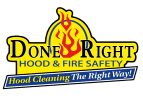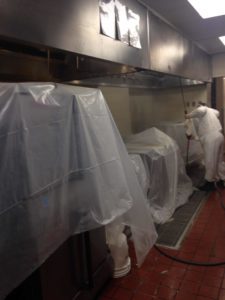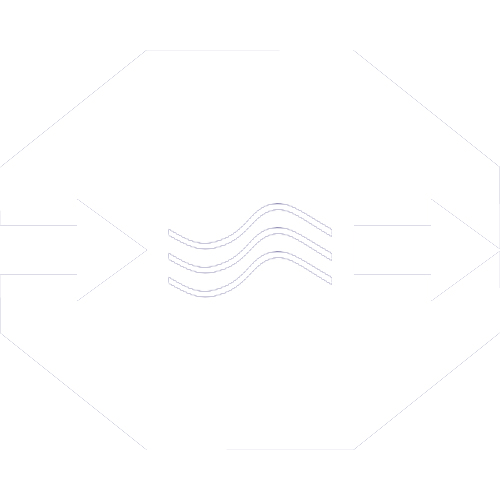When Kitchen Exhaust Maintenance is Done Right
Kitchen Exhaust Maintenance is a critical process that significantly influences the safety and efficiency of any restaurant or commercial kitchen. It’s a procedure that involves thoroughly cleaning the kitchen hood, filters, and ductwork, which will gradually collect grease, smoke, and cooking byproducts – in time, becoming incredibly dangerous.
Neglecting these essential cleaning processes will ultimately pose severe fire hazards and compromises the overall functionality of the kitchen. What’s more, compliance FDNY safety regulations is the result of maintaining a regular cleaning schedule by a certified team of experts.
Components and Functionality of the Kitchen Exhaust System
A thorough understanding of the kitchen exhaust system’s key components and their collaborative functionality is essential to appreciate the importance of its proper kitchen exhaust system maintenance. The system consists of the kitchen hood, filters, ductwork, and fan, each playing a distinct role in capturing and containing heat, smoke, and grease particles. The synergy between these components is vital for maintaining a safe and clean cooking environment.
The Kitchen Hood
The kitchen hood is strategically positioned to capture the rising tide of heat, smoke, and grease plumes that emanate from your culinary endeavors. Think of it as a canopy that acts as a shield, channeling everything upwards towards the additional exhaust components.
The Filtration Firewall: Grease Filters
Within the hood lies a silent defender – the grease filter. Made of robust stainless steel or aluminum, it boasts a maze-like structure of baffles, designed to trap and hold onto those pesky grease particles before they can wreak havoc further down the line. Think of it as a valiant knight intercepting grease projectiles before they reach the delicate ductwork veins.
The Conveying Arteries: Ductwork
Imagine a labyrinthine network of channels snaking through your building, carrying the captured fumes away from the culinary battlefield. That’s the ductwork, a vital circulatory system transporting the unwanted exhaust towards its ultimate destination – the great outdoors. Its intricate pathways ensure the smoky battlefield remains confined, keeping your kitchen a haven of fresh air.
The Engine of Extraction: The Exhaust Fan
The unsung hero of the system, the exhaust fan, breathes life into the entire operation. Its powerful blades churn, generating a potent suction that draws the heat, smoke, and grease upwards through the hood and filters, propelling them along the ductwork’s arteries. It’s the tireless workhorse driving the symphony of clean air.
The Combined Effect
When all of these components are working in unison, the rising heat and smoke are pulled into the hood, drawn upwards by the fan and through the filter where grease surrenders to the baffles, leaving behind a cleaner, purified air stream. Finally, the ductwork carries away this cleansed air, helping to ensure that your kitchen is safe and compliant
Why Does it Matter? The Statistical Stakes of Proper Kitchen Exhaust Maintenance
Maintaining this delicate equilibrium is more than just a matter of good housekeeping. Did you know that grease buildup in kitchen exhaust systems is a leading cause of residential fires, accounting for an estimated 5% of all house fires in the United States? Every year, these fires cause millions of dollars in property damage and injuries.
Studies by the National Fire Protection Association reveal that proper kitchen exhaust maintenance can drastically reduce this risk. A 2017 study found that regular cleaning of exhaust systems in restaurants led to a 58% decrease in fire incidents. These statistics underscore the critical role a well-functioning exhaust system plays in ensuring the safety of your home and loved ones.
From the Beginning: Kitchen Exhaust Maintenance
Just like any critical kitchen appliance your kitchen exhaust system requires regular upkeep to function at its best. Regular restaurant hood cleaning, including the filters, hood, and accessible portions of the ductwork is essential to prevent grease buildup and minimize fire hazards.
Recognizing the Need for Kitchen Exhaust Maintenance
While it’s best to maintain a consistent cleaning schedule, vigilance in recognizing signs that suggest the need for cleaning is crucial for effective system maintenance. Its efficient operation depends on proactive attention, especially recognizing the telltale signs it needs professional cleaning. Failure to do so can disrupt operations, posing risks to safety, health, and even regulatory compliance.
These signs include visible grease buildup, unusual odors, decreased system efficiency, extended time since the last cleaning, frequent smoke alarm triggers, and visible smoke. Addressing these indicators through professional cleaning is essential to prevent hazards and ensure the smooth and safe operation of the kitchen exhaust system.
Visible Grease Buildup: A Glaring Indicator
A prominent symptom of a neglected exhaust system is the presence of visible grease. Dripping on the hood or clinging stubbornly to filters, this accumulated grease is not just an aesthetic concern. It significantly hinders airflow, reducing the system’s efficiency and, more importantly, increasing the risk of fire. Grease buildup exceeding the manufacturer’s recommended levels necessitates immediate professional cleaning to restore optimal performance and mitigate potential hazards.
Diminished Efficiency of the Exhaust System
A struggling exhaust system betrays itself through weakened fan suction, persistent smoke lingering in the kitchen, and unusual noises emanating from its depths. These are harbingers of decreased efficiency, where the system falters in its vital task of removing smoke, heat, and grease. Inefficient systems compromise air quality, exposing occupants to potentially harmful airborne contaminants. Furthermore, they create conditions conducive to fire, making professional cleaning a non-negotiable necessity.
Unpleasant Odors, a Clear Sign Something Needs to Be Addressed
Lingering cooking odors are a clear indicator that kitchen exhaust maintenance is needed. Odors that refuse to dissipate even after diligent ventilation signal another crucial indicator – clogged filters. These filters, once effective barriers, become saturated with grease and food particles, trapping unwanted aromas within the system. Professional cleaning is essential to restore proper ventilation and eliminate these persistent olfactory offenses, ensuring a fresh and inviting kitchen environment.
Frequent Smoke Alarms: An Ominous Indicator
False alarms triggered by the smoke alarm serve as a stark warning. They suggest the system is struggling to handle smoke and heat efficiently, leading to inaccurate readings and potentially masking a brewing fire hazard. Neglecting this indicator can have disastrous consequences, making prompt professional intervention critical to prevent real flames from erupting.
It’s Been Too Long Since the Last Professional Kitchen Exhaust Maintenance
Like any piece of equipment, the kitchen exhaust system benefits from regular attention to maintain optimal performance and safety. Failing to adhere to the manufacturer’s recommended cleaning schedule, typically every 3-6 months, allows grease and debris to accumulate, silently compromising both functionality and safety.
Regular professional cleanings are crucial for ensuring the system continues its harmonious operation, mitigating potential risks, and protecting the health and well-being of everyone in the kitchen.
Beyond the Obvious: Additional Cues for Intervention
Visible smoke, excessive fan noise, and even pest infestations in the ductwork are further red flags demanding professional attention. These seemingly unrelated issues point to a compromised system in need of a thorough cleaning and potential repairs.
A Silent Guardian Deserving Regular Attention
By heeding these indicators and prioritizing regular professional cleaning, we ensure the kitchen exhaust system remains a silent guardian of our culinary endeavors. It will continue to operate at its peak, efficiently removing smoke, heat, and grease.
The Kitchen Exhaust Maintenance Process: A Step-by-Step Guide
Maintaining a pristine kitchen exhaust system is not just about aesthetics; it’s vital for safety and compliance with local fire codes. The cleaning process requires professional expertise and specialized equipment to ensure thoroughness and efficiency. Here’s a step-by-step breakdown of what you can expect:
The Multi-Step Cleaning Process
Preparation involves safeguarding the kitchen area, utilizing plastic sheeting to protect appliances, and implementing a grease containment system. Subsequent stages include manual scraping to remove bulk grease, chemical degreasing, pressure washing for thorough cleansing, inspection, polishing, and the provision of a detailed report with recommendations for future maintenance or repairs.
Preparation
- The kitchen area is carefully prepared to prevent damage and ensure safety.
- Sensitive appliances and surfaces are covered with protective sheeting.
- A dedicated grease containment system is set up to capture the removed grease and grime.
 Scraping
Scraping
- Technicians manually remove the bulk of grease buildup from the hood, filters, and accessible ductwork using specialized tools.
- This initial step clears the way for deeper cleaning in subsequent stages.
Chemical Degreasing
- Powerful chemical degreasers are applied throughout the system, including hard-to-reach areas within the ductwork.
- These chemicals are designed to break down and loosen stubborn grease deposits.
- They are typically allowed to dwell for a specific time to maximize their effectiveness.
Pressure Washing
- After the chemical treatment, technicians use high-pressure hot water to flush away the loosened grease and chemical residue.
- This thorough process ensures all parts of the system, including long stretches of ductwork, are fully cleaned.
Inspection and Polishing
- Once the entire system is cleaned, technicians meticulously inspect it to ensure no areas were missed.
- Any remaining grease or grime is removed, and residual mess from the cleaning process is cleared.
- Finally, the visible components, such as the hood and filters, are polished to restore their original appearance.
Report and Recommendations
- A detailed report is provided outlining the work performed, any areas of concern discovered during the cleaning, and recommendations for future maintenance or necessary repairs.
Remember, entrusting the kitchen exhaust maintenance process to trained and FDNY certified professionals is critical. Their expertise guarantees safe and effective cleaning, ensuring your kitchen exhaust system operates optimally and remains compliant with local safety regulations. Most importantly, it’s a requirement to maintaining code compliance.
Regular cleanings by qualified professionals protect your investment in the system, safeguard your kitchen’s safety, and contribute to a healthy cooking environment.
Kitchen Exhaust Maintenance Frequency
The efficacy of kitchen exhaust maintenance, specifically cleaning frequency, is tightly correlated with the volume of kitchen activity taking place. As one would expect, the volume of activity within any particular restaurant or commercial kitchen will impact the cleaning schedule.
Solid Fuel Culinary Operations
This category encompasses cooking methods utilizing solid fuels like wood, charcoal, or similar alternatives. These produce an abundance of smoke and particulate matter, necessitating a vigilant approach to system upkeep. Monthly inspections and professional cleaning are strongly recommended to guarantee both operational safety and optimal efficiency.
High-Volume Cooking Environments
Establishments characterized by continuous or near-continuous cooking activities, such as 24-hour diners, fast food chains, or kitchens employing charbroiling or wok-cooking techniques, fall under this category. The elevated generation of grease and smoke dictates a more frequent maintenance schedule. Quarterly inspections and cleaning are deemed essential for ensuring compliance with safety regulations and minimizing fire risks.
Moderate-Volume Cooking Operations
Full-service restaurants exemplify this category, where cooking, albeit regular, is not continuous. The recommended cleaning and inspection frequency for these systems stands at semi-annually, or twice per year. This periodicity strikes a balance between cost-effectiveness and maintaining a safe and efficient operating environment.
Low-Volume Cooking Venues
Churches, day camps, seasonal businesses, and senior centers exemplify this category, characterized by infrequent or small-scale cooking activities. The diminished quantity of cooking translates to a less demanding maintenance schedule. Annual inspections and professional cleaning are generally sufficient for such kitchens, although local regulations may dictate more stringent protocols.
Of course, it’s important to understand that these are general guidelines, and specific circumstances may necessitate tailored maintenance plans. Adherence to FDNY codes and safety regulations is of utmost importance. And, as already covered, trusting your own inspection and experiences within the kitchen. Dangerous buildup is a lot like an iceberg: what you can see on the surface is likely just the tip, with much larger dangers collecting where you cannot see them. Regular professional cleaning not only optimizes the exhaust system’s performance and longevity but it will also play an important role in mitigating fire hazards. All of which ultimately contributes to the overall safety and well-being of your restaurant or commercial kitchen.
Wrapping Up
Neglecting kitchen exhaust maintenance is an invitation to disaster. By recognizing the telltale signs and prioritizing regular professional cleaning, you ensure optimal performance, mitigate fire risks, and comply with safety regulations.
Remember, the frequency of cleaning depends on your cooking habits, and local regulations may dictate specific protocols. Consult your system’s manual, engage qualified professionals, and let regular cleanings orchestrate a harmonious safety symphony in your kitchen. Embrace the science behind a clean exhaust system, and create culinary masterpieces under the protective shield of pure, uncontaminated air.

 Scraping
Scraping














